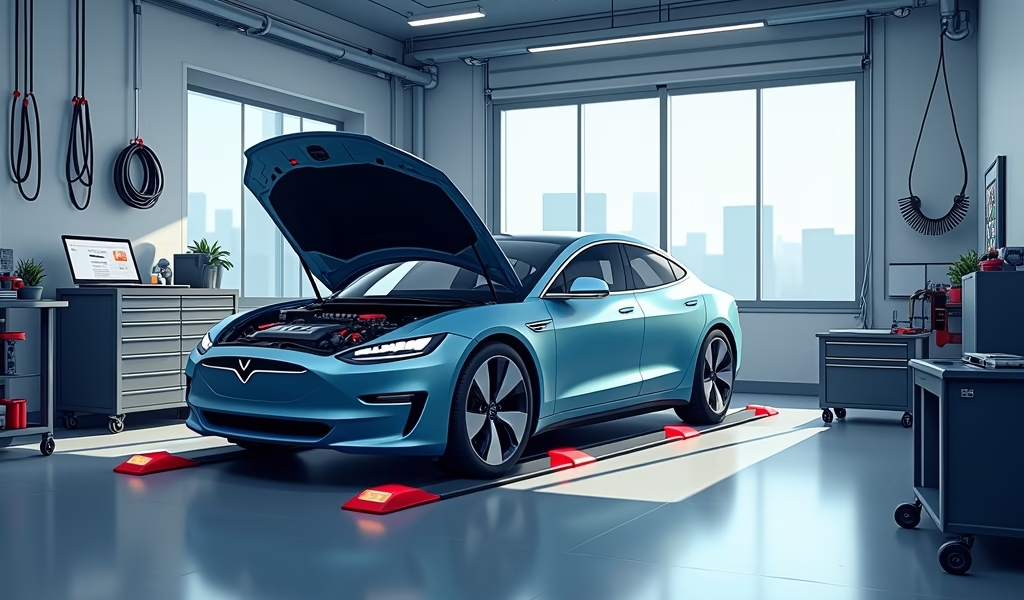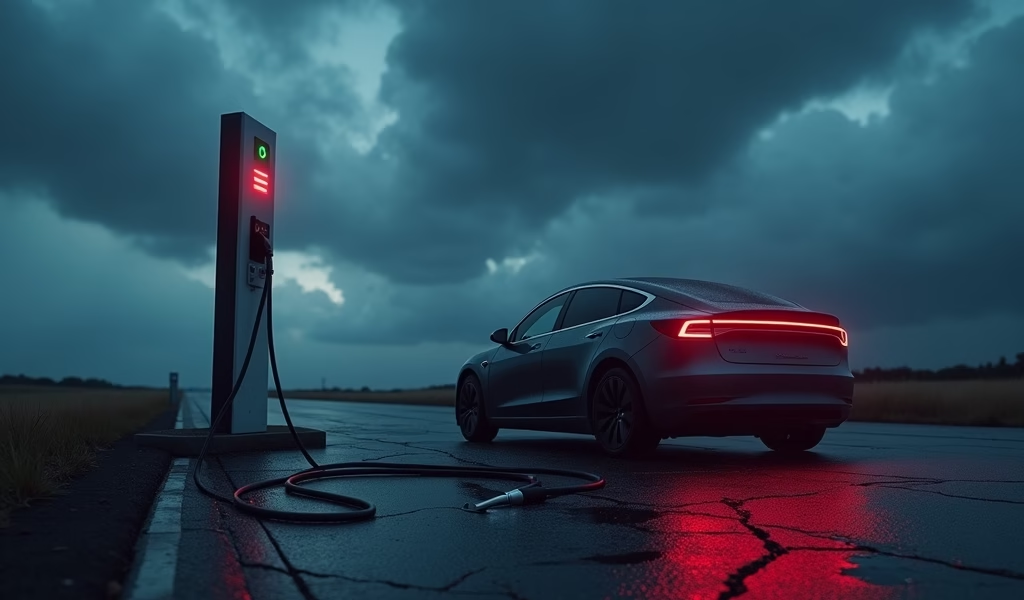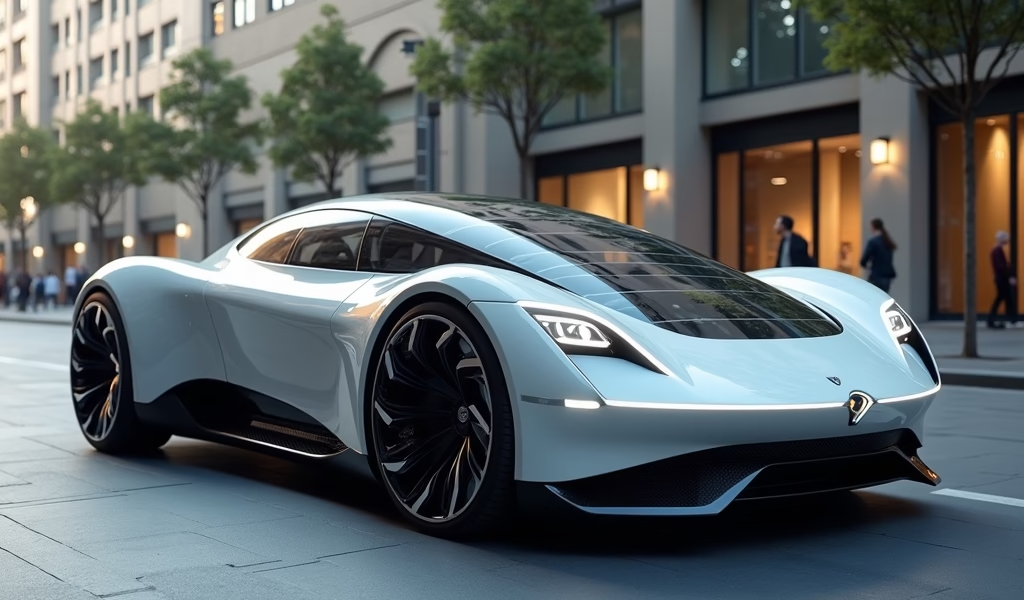Overview
This article addresses the five main limitations of electric vehicles—range anxiety, charging infrastructure gaps, high initial cost, battery longevity concerns, and winter performance issues—while providing practical solutions for each challenge. The author, an experienced automotive technician, emphasizes that while these limitations are real, they can be effectively managed with proper planning and techniques, making EV ownership increasingly viable for most drivers.
Table of Contents
- Understanding EV Limitations: The Real Story
- Range Anxiety: It’s Real, But So Are the Solutions
- Charging Infrastructure: Navigating a Work in Progress
- Initial Cost: Balancing the Price Tag with Long-Term Savings
- Battery Concerns: Addressing Lifespan and Replacement
- Winter Performance: Keeping Your EV Happy in Cold Weather
- Conclusion: Embracing Electric Without the Headaches
- Frequently Asked Questions
Understanding EV Limitations: The Real Story
As someone who’s had their hands under the hood of everything from classic muscle cars to the latest electric vehicles, let me tell you – the cons of electric cars are real, but they’re not deal-breakers. Electric vehicles represent a seismic shift in automotive technology, bringing with them a unique set of challenges alongside their impressive benefits.
After 20+ years working as an automotive technician and now specializing in EV servicing, I’ve heard every concern in the book. “They’ll leave me stranded!” “The battery will die after three years!” “I can’t drive it in the snow!” Sound familiar?
What most potential EV owners don’t realize is that many of these limitations have practical solutions that can transform the electric driving experience from anxiety-inducing to absolutely liberating. Like any technology transition – remember when we worried about smartphones not lasting a day? – we’re in an adaptation phase.
In this comprehensive guide, we’ll explore the five most significant cons of electric cars and, more importantly, the proven fixes that make living with an EV not just manageable but genuinely enjoyable. Whether you’re considering making the switch or already own an EV and looking to optimize your experience, these insights will help you navigate the electric road ahead.
Range Anxiety: It’s Real, But So Are the Solutions
Range anxiety – that nagging fear that you’ll run out of charge before reaching your destination – tops the list of cons of electric cars. It’s the automotive equivalent of watching your phone battery dip into the red zone while you’re expecting an important call.
The average electric vehicle today offers between 200-300 miles of range on a full charge. While this covers most daily commutes several times over (the average American drives about 39 miles per day), it can feel constraining compared to the 400+ miles typical of gasoline vehicles.
But here’s the thing – this limitation is more psychological than practical for most drivers. When was the last time you actually drove 300 miles without stopping? For the vast majority of us, it’s a rare occurrence.
Proven Fixes for Range Anxiety:
- Route planning with charging stops: Apps like PlugShare, ABRP, and manufacturers’ native navigation systems now plan routes with charging stations automatically factored in. These smart systems even account for elevation changes, weather conditions, and your car’s specific energy consumption patterns.
- Preconditioning: Most newer EVs allow you to pre-condition the battery while still connected to a charger. This brings the battery to its optimal temperature before departure, maximizing range efficiency especially in extreme weather.
- Driving technique adjustments: Simple changes like using regenerative braking effectively (what I call “the one-pedal dance”) and maintaining steady speeds can extend your range by 10-15%. It’s like learning to drive all over again, but in a good way.
- Regular tire pressure checks: I can’t stress this enough – properly inflated tires can improve your EV’s efficiency by 3-5%. That might not sound like much, but it’s an easy 10-15 miles of extra range.
One of my clients, Sarah, was terrified of making the 180-mile trip to visit her daughter in college after buying her Nissan Leaf. After we walked through proper planning and efficient driving techniques, she not only made the trip comfortably but arrived with 22% battery remaining – enough to show her daughter around town before charging.

Charging Infrastructure: Navigating a Work in Progress
When discussing cons of electric cars, charging infrastructure limitations often come up as a close second to range anxiety. Unlike the ubiquitous gas station network built over a century, EV charging infrastructure is still developing, creating a patchwork of availability that varies dramatically by region.
Urban areas typically offer abundant charging options, while rural regions might have concerning gaps. Additionally, not all chargers are created equal – you’ll find everything from slow Level 1 (120V) outlets that add about 4-5 miles of range per hour to DC fast chargers that can add 200+ miles in 30 minutes.
Then there’s the reliability factor. As a mechanic who regularly road-trips in an EV, I’ve encountered my share of broken or occupied chargers. It’s like arriving at a gas station to find all the pumps wrapped in “out of order” tape – except you can’t just drive to the next one that’s three blocks away.
Proven Fixes for Charging Challenges:
- Home charging installation: This is the game-changer that most new EV owners underestimate. Installing a Level 2 charger at home means waking up to a “full tank” every morning. It’s like having a personal gas station that fills your car while you sleep.
- Charger network memberships: Sign up for 2-3 major charging networks in your region. Most offer apps showing real-time availability and allowing you to initiate charging sessions remotely. Many newer EVs are also adopting “Plug and Charge” technology, eliminating the need for apps or cards entirely.
- Workplace charging advocacy: More employers are installing charging stations as employee perks. A friendly conversation with HR or facilities management might result in charging access that doubles your effective daily range.
- Strategic charging: Charge during meals or activities you’d stop for anyway. I’ve discovered some of my favorite local coffee shops while waiting for a 20-minute top-up.
The charging infrastructure is expanding rapidly, with billions being invested in new installations nationwide. What feels like a limitation today will likely be a non-issue within 2-3 years.
Remember: Most EV owners (about 80% according to studies) do the vast majority of their charging at home or work, using public chargers primarily for road trips. This makes the infrastructure limitations far less impactful than they initially appear.
Initial Cost: Balancing the Price Tag with Long-Term Savings
Let’s talk money – specifically, the sticker shock that can make potential buyers hesitate. The higher upfront cost ranks prominently among the cons of electric cars, with many EVs priced $5,000-$15,000 above their combustion counterparts. It’s like paying for several years’ worth of gas in advance.
For budget-conscious consumers, this price premium can be a significant hurdle. When I discuss vehicle options with my clients, this initial investment is often the biggest sticking point, even when they’re otherwise enthusiastic about going electric.
What’s often missing from this conversation is a complete cost analysis. The true cost of vehicle ownership extends far beyond the purchase price, and this is where EVs begin to shine.
Proven Fixes for Cost Concerns:
- Federal and state incentives: The federal tax credit of up to $7,500 dramatically reduces costs for many EVs. Many states offer additional rebates or incentives that can knock thousands more off the effective price. I’ve had clients effectively save $10,000+ through combined incentives.
- Maintenance savings calculations: EVs eliminate oil changes, transmission services, exhaust system repairs, and dozens of other maintenance items. As a mechanic, I estimate most drivers save $1,000-$2,000 annually on maintenance alone. That’s money that stays in your pocket.
- “Fuel” cost reduction: Electricity is substantially cheaper than gasoline per mile. The average EV costs $500-$800 annually to charge, compared to $2,000-$3,000 for gasoline vehicles. Track your current fuel spending for accurate comparisons.
- Depreciation considerations: While historically EVs depreciated faster than gas vehicles, this trend is reversing as battery technology improves and mainstream adoption increases. Some models like Tesla have shown exceptional value retention.
One of my clients, Mark, was hesitant about the $45,000 price tag on a new EV. We calculated his actual five-year cost of ownership compared to his current SUV, factoring in incentives, fuel savings, and maintenance reduction. The result? The EV would cost him about $6,200 less over five years, even with the higher upfront price.
Many manufacturers are also offering increasingly competitive lease options for EVs, allowing drivers to benefit from the lower operating costs while avoiding concerns about long-term battery ownership.
Battery Concerns: Addressing Lifespan and Replacement
Battery degradation and replacement costs represent some of the most legitimate cons of electric cars, particularly for those planning to keep their vehicles long-term. Unlike an engine that might run for 200,000+ miles with proper maintenance, EV batteries do gradually lose capacity over time.
The prospect of paying $10,000-$20,000 for a replacement battery pack can be terrifying. I’ve seen potential buyers walk away from great electric vehicles based on this concern alone. It’s the automotive equivalent of worrying your smartphone battery will eventually die – except replacing an EV battery costs as much as several new phones.
But here’s the reality check from someone who works with these systems: modern EV batteries are proving remarkably durable, and the management systems protecting them grow more sophisticated with each model year.
Proven Fixes for Battery Concerns:
- Understanding battery warranties: Most manufacturers offer 8-10 year/100,000+ mile battery warranties that guarantee against excessive degradation (typically defined as below 70% of original capacity). This provides substantial protection during the period when most people own their vehicles.
- Battery preservation practices: Avoid routine charging to 100% and discharging below 20% when possible. I tell my clients to think of it like avoiding filling your coffee cup to the absolute brim – a little space prevents spills. Most EVs now allow you to set charging limits for everyday use.
- Temperature management: Extreme heat accelerates battery degradation. When possible, park in the shade and use pre-conditioning while still plugged in during very hot weather. Many newer EVs have sophisticated thermal management systems that handle this automatically.
- Real-world data perspective: Tesla vehicles with 200,000+ miles typically retain 90% or more of their original battery capacity. Similar promising data is emerging for other manufacturers. These batteries are outlasting initial projections.
Battery technology is also advancing rapidly, with costs declining approximately 13% annually over the past decade. By the time most current EVs need replacement batteries, the cost will likely be substantially lower than today’s prices.
Additionally, a growing market for battery refurbishment and module replacement means many battery issues can be resolved without replacing the entire pack, similar to how an engine rebuild costs less than a complete engine replacement.

Winter Performance: Keeping Your EV Happy in Cold Weather
Among the cons of electric cars, winter performance concerns are particularly relevant for drivers in colder climates. Battery chemistry simply works more efficiently at moderate temperatures, and the laws of physics aren’t easily negotiated with.
In my shop, I see a predictable pattern every winter: a wave of new EV owners experiencing their first cold-weather range shock. When temperatures drop below freezing, range reductions of 20-40% are common. It’s like suddenly having a smaller gas tank when the temperature drops.
Additionally, heating an EV cabin requires energy from the battery, unlike gas cars that use “free” waste heat from the inefficient combustion process. Every bit of warmth you enjoy comes at the cost of driving range.
Proven Fixes for Winter Performance Issues:
- Precondition while plugged in: Warming the battery and cabin while still connected to a charger is the single most effective winter strategy. This uses grid electricity rather than battery energy and starts your journey with optimal battery temperature.
- Seat and steering wheel heaters: These use far less energy than heating the entire cabin. I advise my clients to keep the cabin temperature moderate (68°F rather than 74°F) and use seat heaters for personal comfort.
- Garage parking when possible: A 40°F garage is significantly better for battery performance than a 10°F driveway. Even an unheated garage provides meaningful benefits in extreme climates.
- Winter range expectations: Simply planning for 70-75% of your normal range during cold months eliminates surprises. Build this buffer into your routine just as you’d wear a heavier coat in winter.
- Heat pump systems: Many newer EVs feature heat pump climate systems rather than resistive heating. These can be 300% more efficient, dramatically reducing winter range impact. If you live in a cold climate, prioritize models with this feature.
One of my clients in Minnesota was initially disappointed with his EV’s winter performance, losing nearly 40% of range on sub-zero days. After implementing these strategies, particularly pre-conditioning and using seat heaters instead of blasting the cabin heat, he reduced his winter range loss to about 25% – a significant improvement that restored his confidence in the vehicle.
It’s worth noting that research from Recurrent Auto shows that while cold weather affects all EVs, newer models with more sophisticated thermal management systems show substantially improved winter performance compared to earlier generations.
Conclusion: Embracing Electric Without the Headaches
The cons of electric cars are real, but so are the solutions. After two decades in the automotive industry and witnessing the rapid evolution of EVs, I’m convinced that most limitations are either temporary growing pains of a maturing technology or manageable with the right approach.
Range anxiety fades with experience and planning. Charging infrastructure improves monthly. The cost equation increasingly favors electric. Battery concerns are proving largely overblown based on real-world data. And winter performance, while still challenging, can be effectively managed with proper techniques.
Like any significant change, transitioning to electric driving requires some adaptation. Remember when we worried about smartphone battery life or finding WiFi? Those concerns seem quaint now because the technology improved and we developed new habits. The same transformation is happening with electric vehicles, just on wheels instead of in our pockets.
For those considering making the switch, I encourage you to test drive several models, talk with current owners about their real-world experiences, and consider how an EV would fit into your specific driving patterns. Most people discover that the benefits – the instant torque, the smooth quiet ride, the convenience of home charging, the minimal maintenance – quickly outweigh the adjustments required.
The electric revolution isn’t coming – it’s already here. And with these proven fixes for the common cons of electric cars, you can join it without the headaches that early adopters faced. The road ahead is electric, and it’s getting smoother every day.
Frequently Asked Questions
How much does it cost to replace an EV battery?
Currently, full battery replacement costs range from $5,000 to $20,000 depending on vehicle model and battery size. However, most batteries are warranted for 8-10 years, and prices are declining steadily.
Do electric cars lose value faster than gas cars?
Earlier EV models did depreciate faster, but this trend is reversing as technology matures and demand increases. Many current EVs, particularly premium models, now retain value comparably to gas vehicles.
Can electric cars handle extreme cold?
Yes, electric cars function in extreme cold, but expect 20-40% range reduction in sub-freezing temperatures. Pre-conditioning while plugged in significantly improves cold-weather performance.
How long does it take to charge an electric car?
Charging times vary widely: 8-12 hours on a home Level 2 charger for a full charge, or 20-40 minutes to 80% at a DC fast charger. Most owners charge overnight at home, waking to a full battery.
What happens if my electric car runs out of charge?
Similar to running out of gas, you’ll need roadside assistance for a tow to the nearest charging station. Modern EVs provide extensive warnings and navigation to charging points well before this happens.

